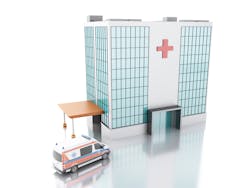Survey gleans surprising results about hospital violence
No hospital can afford to ignore acts of violence, the potential for crime and terrorism, and the response to and mitigation of emergency incidents. A new survey finds at least some of these are on the rise, with one in three U.S. hospitals reporting an increase in violence and assaults in 2014—despite widespread rising security budgets.
The survey of 380 hospital administrators, chief security officers and staff was conducted by Guardian 8 Corporation to shed light on recent trends in hospital violence and assault, and to gauge top concerns and response options. According to the survey (http://www.guardian8.com/blog/us-hospitals-report-rise-in-violence):
- Top security concerns included the safety of patients and security officers as well as disruptions to patient care;
- Reported increases in attacks and assaults included violence by patients and/or their families against emergency department personnel and staff such as nurses;
- Nearly half of respondents (46 percent) reported increasing their security budgets in 2014.
The big takeaway here is obvious: No hospital facility can achieve its crucial mission of providing quality patient care without proper security to ensure patient, staff and visitor safety. But there’s a domino effect that may be less evident: The inability to properly address a violent situation not only affects the morale of security personnel, but also of the doctors and nurses around them. Low morale makes recruiting and retention a serious issue across the board. In the case of security staff—where turnover is as high as 300 percent to 400 percent per year—poor morale exacerbates an already dire challenge.
An equipment issue
In addition to highlighting the importance of proper security on hospital campuses, the findings point to a need to minimize security officer turnover as an integral part of your hospital’s overall security solution.
I firmly believe high turnover in the hospital security industry is an equipment issue more than a matter of pay. You cannot pay someone enough to take a job they consider too dangerous. Conversely, when security officers feel safe, properly equipped and well prepared, they are less likely to leave. Hospital administrators rely on the security director to recommend the smartest, safest security solutions, including the tools you choose for your non-sworn officers’ duty belts.
In our "10 Indispensable Hospital Security Tips," we urge security directors to take a fresh look at response strategies and smarter personal defense tools now available to enhance the safety and effectiveness of your security professionals.
What are the smartest, safest tools for hospital security officers today?
As a provider of enhanced non-lethal (ENL) devices, such as the Pro V2, built for the security industry, Guardian 8 offers a number of recommendations. For example, consider developing a method for tracking and reporting violence incidents, such as implementing adequate audio and video recording in the ER. Also worth thinking about: equip officers with cameras to document security incidents, implement a security dashboard to keep track of security incident data, and take the time to evaluate non-lethal defense tools.
Insist on the right tools
Once you’ve conducted your due diligence, insist on getting the right tools for the job. If necessary, in order to increase your prospects of procuring the equipment your officers need, build the case with dollar signs attached that show your hospital cannot afford to not purchase the proper equipment. Violent incidents lead to injuries and lost workdays. Add to that the high cost of replacing staff, estimated at 25 percent to 200 percent of the employee’s annual salary to cover the costs of advertising, interviewing, background checks, hiring and training. And then there are those costly intangibles—such as the first-hand knowledge of your hospital’s facilities, risks and protocols that a security officer takes with them when they quit.
Other survey highlights include the following:
- Respondents’ top security concerns: patient safety (57 percent), officer safety (56 percent), disruptions to patient care (24 percent)
- Response options: 15 percent of hospital security personnel are unarmed; 28 percent are armed and 57 percent of respondents are already deploying "intermediate" non-lethal solutions
- Variety of equipment carried by hospital security personnel: pepper spray (41 percent), two-way communication system (40 percent), baton (37 percent), stun gun (28 percent), on security officer video (26 percent)
- Seventy percent of respondents use an incident reporting system that includes a dashboard of activities for review
- Fifty-one percent of respondents said they would feel comfortable moving away from their current security options
The survey also says that 59 percent of respondents reported being unfamiliar with laws in their state restricting the use of non-lethal weapons. So if hospital administrators deny a request for security equipment for regulatory reasons, ask for the code or regulation in question. The stakes are too high to do anything less.
About the Author: Paul Hughes is COO of Guardian 8.
